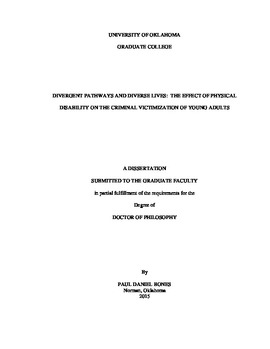| dc.description.abstract | Official statistics show that physical disability is strongly associated with an increased risk of experiencing violent and sexual victimization, but researchers know little about why this occurs. Do offenders target physical disability itself, or is impairment so strongly linked to other characteristics related to criminal victimization, that disability increases victimization indirectly? This dissertation examines how physical disability, demographic traits, home and family characteristics, lifecourse transitions, risky behaviors, and neighborhoods affect both violent and sexual victimization. Data from the National Longitudinal Study of Adolescent Health (Add Health), Wave IV, was used to examine how physical disability creates pathways to victimization. I used mixed effect logistic regression, t-tests, and multi-group analysis with binary logistic regression to describe how disability itself acts as a pathway to victimization, and how the effects of common predictors behave differently for the disabled. Results indicate that a visible signifier of impairment directly increases the risk of sexual assault by a non-parent or guardian, but does not directly affect violent victimization. Lifecourse transitions such as increased education, owning a home, and marriage all decrease the risk of violent victimization for the non-disabled, but either have no effect for the disabled, or increase their risk. A history of criminal offending and drug use increase the risk of violence for the non-disabled, but have no effect on the disabled. Marriage and residential stability decreased the risk of sexual assault for the non-disabled, but not the disabled. Risk factors played a significant role in predicting sexual victimization. The effect of different forms of abuse varied by disability status, but in all cases where a factor had a significant effect, it was greater for the non-disabled. | en_US |
